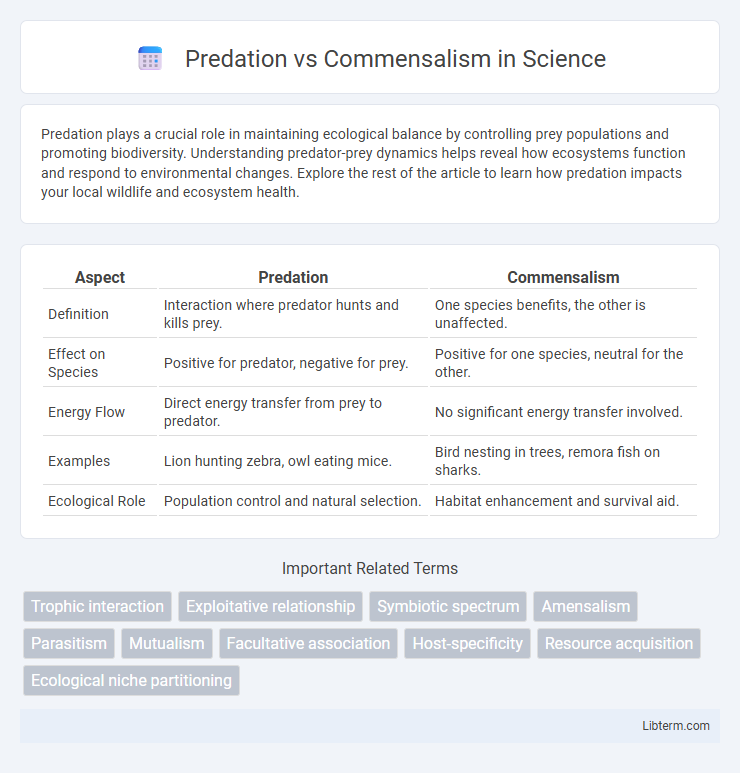Predation plays a crucial role in maintaining ecological balance by controlling prey populations and promoting biodiversity. Understanding predator-prey dynamics helps reveal how ecosystems function and respond to environmental changes. Explore the rest of the article to learn how predation impacts your local wildlife and ecosystem health.
Table of Comparison
| Aspect | Predation | Commensalism |
|---|---|---|
| Definition | Interaction where predator hunts and kills prey. | One species benefits, the other is unaffected. |
| Effect on Species | Positive for predator, negative for prey. | Positive for one species, neutral for the other. |
| Energy Flow | Direct energy transfer from prey to predator. | No significant energy transfer involved. |
| Examples | Lion hunting zebra, owl eating mice. | Bird nesting in trees, remora fish on sharks. |
| Ecological Role | Population control and natural selection. | Habitat enhancement and survival aid. |
Introduction to Ecological Interactions
Ecological interactions shape the dynamics of ecosystems through various relationships between species, including predation and commensalism. Predation involves one organism, the predator, consuming another, the prey, significantly influencing population control and evolutionary adaptations. Commensalism describes a relationship where one species benefits without harming or helping the other, often seen in species that share habitats but do not compete directly.
Defining Predation: Nature and Examples
Predation is a biological interaction where a predator hunts, kills, and consumes its prey, playing a crucial role in regulating population dynamics and ecosystem balance. Examples include lions preying on zebras in African savannas and owls hunting rodents in forest habitats. This interaction contrasts with commensalism, where one species benefits without harming the other, highlighting different survival strategies in nature.
Understanding Commensalism: Key Concepts
Commensalism is an ecological relationship where one species benefits while the other remains unaffected, unlike predation where one organism harms another. Key concepts include the host providing shelter, transport, or food to the commensal species without any significant impact on itself. Understanding commensalism helps clarify species interactions, ecosystem dynamics, and biodiversity maintenance.
Ecological Roles: Predators vs. Commensals
Predators play a crucial ecological role by regulating prey populations, which helps maintain ecosystem balance and biodiversity. Commensals benefit from their hosts by gaining resources or shelter without harming or benefiting the host, contributing to species diversity and ecosystem complexity. These interactions shape community structures, influencing energy flow and nutrient cycling within habitats.
Survival Strategies and Adaptations
Predation involves predators evolving sharp teeth, claws, and enhanced senses to capture prey effectively, while prey species develop camouflage, speed, and defensive behaviors as survival strategies. Commensalism features one organism benefiting without harming the host, often through adaptations like specialized limbs for attachment or mimicry for protection. These relationships showcase diverse evolutionary adaptations aimed at maximizing survival within ecosystems.
Impact on Population Dynamics
Predation directly affects population dynamics by reducing the prey population, often leading to cyclical fluctuations in both predator and prey numbers. Commensalism influences population dynamics more subtly, as the commensal species benefits without significantly impacting the host population size or growth. The predator-prey relationship drives natural selection and ecosystem balance, whereas commensalism promotes species coexistence without causing major population shifts.
Energy Transfer in Food Webs
Predation involves direct energy transfer as predators consume prey, converting biomass into predator energy, which drives population control and ecosystem stability. In contrast, commensalism contributes indirectly to energy flow by benefiting one species without affecting the host, often enhancing nutrient cycling or habitat complexity. Both interactions shape food web dynamics, influencing energy distribution and trophic relationships essential for ecosystem functioning.
Evolutionary Significance of Predation and Commensalism
Predation drives evolutionary adaptations through natural selection, promoting traits like camouflage, speed, and defensive mechanisms that enhance survival and reproductive success. Commensalism influences evolutionary pathways by facilitating species interactions that provide benefits such as improved resource access or habitat without harming the host, enabling niche differentiation and biodiversity. Both interactions shape ecosystem dynamics and evolutionary genetics by affecting species fitness, population structures, and coevolutionary relationships.
Real-World Case Studies and Examples
Predation is exemplified by the classic relationship between lions and zebras in the African savanna, where lions hunt and consume zebras, directly impacting prey populations and ecosystem dynamics. Commensalism is observed in epiphytic orchids growing on tropical trees, gaining elevated access to sunlight without harming the host tree. Real-world studies highlight how predation regulates species populations, while commensalism fosters biodiversity by allowing species to coexist with minimal negative impact.
Conclusion: Comparing Predation and Commensalism
Predation involves one organism benefiting by consuming another, leading to a clear predator-prey dynamic, while commensalism features one species benefiting without harming or benefiting the other. The ecological impact of predation often regulates population sizes and influences evolutionary adaptations, whereas commensalism promotes species coexistence without direct competition. Understanding these interactions highlights the complexity of ecosystems and the diverse survival strategies organisms employ.
Predation Infographic

 libterm.com
libterm.com